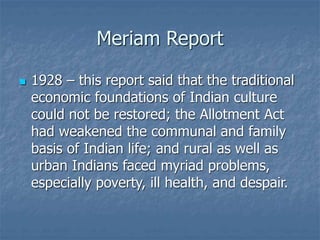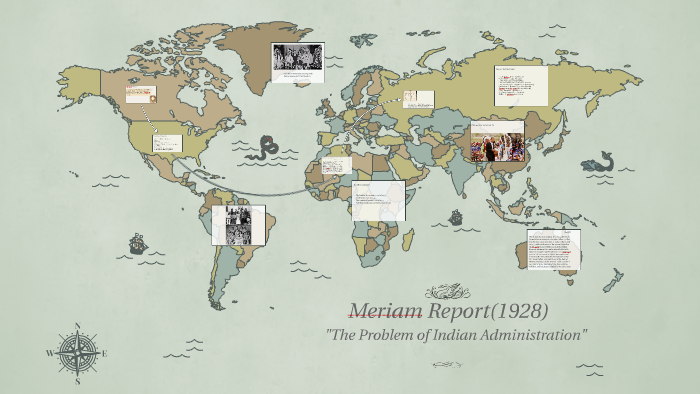
A Reckoning and a Blueprint: The Enduring Legacy of the Meriam Report of 1928
In the annals of American history, few documents have starkly illuminated a nation’s failings and simultaneously offered a transformative path forward with the precision and courage of the Meriam Report of 1928. Officially titled "The Problem of Indian Administration," this exhaustive 847-page study, commissioned by the Secretary of the Interior and conducted by the Brookings Institution, laid bare the devastating realities faced by Native Americans under the prevailing federal policies. It was a watershed moment, a searing indictment of forced assimilation, poverty, and administrative neglect, and its recommendations would serve as the bedrock for a fundamental paradigm shift in U.S. Indian policy for decades to come.
Before the Meriam Report, federal Indian policy was largely defined by the Dawes Act of 1887, an ill-conceived attempt to "civilize" Native Americans by breaking up communal tribal lands into individual allotments. The theory was that by forcing Native people into Euro-American farming practices and individual land ownership, they would assimilate into mainstream society, shed their cultural identities, and achieve economic self-sufficiency. The reality, as Meriam and his team meticulously documented, was catastrophic. By 1928, Native landholdings had plummeted from 138 million acres in 1887 to just 48 million, much of which was arid and unproductive. Tribes were dispossessed, cultures were suppressed, and a vast population was plunged into destitution.
It was against this backdrop of widespread suffering and growing public concern that Secretary of the Interior Hubert Work initiated the study in 1926. He tasked the Brookings Institution, a non-profit public policy organization, with conducting an independent and comprehensive survey of Indian conditions and the administration of the Bureau of Indian Affairs (BIA). The research team, led by social scientist Lewis Meriam, included experts in various fields: health, education, economics, law, and social work. They spent two years visiting reservations, interviewing Native people, BIA employees, and local officials, collecting data that painted an undeniable picture of systemic failure.
The report did not mince words. It described the BIA as an inefficient, underfunded, and often incompetent bureaucracy, characterized by paternalism and a profound lack of understanding of Native cultures and needs. Its most damning finding was the pervasive poverty and suffering. "An overwhelming percentage of the Indians are poor, many of them extremely poor," the report stated, emphasizing that "the health of the Indians is bad. The death rate is high, especially among infants. Tuberculosis is prevalent. Trachoma, a serious eye disease, is widespread." The conditions in Indian boarding schools, designed to strip children of their language and culture, were highlighted as particularly egregious, marked by overcrowding, inadequate nutrition, harsh discipline, and a curriculum that failed to prepare students for any viable future.
The Core Recommendations: A Blueprint for Reform

The Meriam Report’s true power lay not just in its scathing critique but in its detailed and progressive recommendations, which collectively called for a radical departure from the assimilationist policies of the past. These recommendations can be categorized into several key areas:
-
Shift in Fundamental Philosophy:
The report argued that the primary objective of federal policy should no longer be forced assimilation, but rather to promote the economic and cultural well-being of Native Americans, allowing them to adapt to modern life on their own terms. It advocated for fostering self-sufficiency while respecting tribal identities and traditions. This was a monumental shift, recognizing the inherent value of Native cultures rather than viewing them as obstacles to be overcome. -
Education Reform:
Perhaps one of the most impactful sections, the report called for a complete overhaul of the Indian education system. It advocated for:
- Ending the boarding school system: The report exposed the detrimental effects of removing children from their families and cultures. It recommended replacing these institutions with community-based day schools, located on or near reservations, allowing children to remain with their families.
- Culturally relevant curriculum: Education should be tailored to the specific needs and cultural backgrounds of different tribes, incorporating Native languages and traditions, rather than imposing a uniform Euro-American model.
- Vocational training: The report emphasized practical, vocational training that would equip Native youth with skills relevant to their local economies, promoting economic independence.
- Improved teacher quality and facilities: It called for better-trained teachers, smaller class sizes, and modern facilities.
-
Healthcare Improvements:
Recognizing the dire health statistics, the report urged for significant investments in Indian health services. Recommendations included:- Increased funding and personnel: More doctors, nurses, and public health workers were desperately needed.
- Focus on preventative care: Emphasizing sanitation, hygiene, and disease prevention, particularly for tuberculosis and trachoma.
- Improved nutrition: Addressing the widespread malnutrition on reservations.
- Modern hospitals and clinics: Upgrading dilapidated facilities and building new ones.
-
Economic Development and Land Management:
The report recognized that land loss and lack of economic opportunity were at the root of Native poverty. It recommended:- Ending allotment: The report unequivocally called for an end to the further fragmentation of tribal lands and urged policies to consolidate and restore tribal land bases.
- Agricultural and resource management: Providing credit, training, and resources to help Native people develop sustainable agriculture, livestock raising, and resource management practices.
- Diversified economies: Supporting the development of various industries and employment opportunities on reservations.
- Protecting Native water rights and resources.
-
Administrative Reform of the BIA:
The report argued that the BIA needed a complete overhaul to become an effective and culturally sensitive agency. Key recommendations included:- Professionalization: Hiring qualified personnel based on merit, not political patronage.
- Decentralization: Granting more autonomy to local agencies and tribal governments, reducing the top-down control from Washington.
- Increased salaries: To attract and retain competent staff.
- Consultation with Native communities: Emphasizing that BIA decisions should be made in consultation with the people they serve.
-
Protection of Cultural and Religious Freedom:
The report called for an end to the suppression of Native languages, religions, and ceremonies, advocating for respect for tribal sovereignty and self-determination. It recognized that cultural vitality was crucial for the psychological and social well-being of Native communities.
Immediate Impact and the "Indian New Deal"
While the Hoover administration, which received the report, initially moved slowly on its recommendations, the Meriam Report had a profound and immediate impact on public discourse and policy-making. Its findings were so compelling that they were impossible to ignore. Its true influence blossomed during Franklin D. Roosevelt’s New Deal era, particularly under the leadership of John Collier, who became Commissioner of Indian Affairs in 1933. Collier, a staunch critic of the Dawes Act and a proponent of tribal self-governance, found in the Meriam Report a detailed roadmap for his ambitious reforms.
The most direct legislative outcome was the Indian Reorganization Act (IRA) of 1934, often referred to as the "Indian New Deal." This landmark legislation directly implemented many of the Meriam Report’s core recommendations:
- It ended the allotment policy, prohibiting further division of tribal lands and even allowing for the restoration of surplus lands.
- It encouraged tribal self-government through the adoption of tribal constitutions and corporate charters.
- It provided funds for tribes to purchase new lands and established a revolving credit fund for economic development.
- It prioritized Native Americans in BIA hiring.
The IRA, while not without its own complexities and criticisms (some tribes resisted its imposed governmental structures), fundamentally shifted federal policy from assimilation to a recognition of tribal sovereignty and self-determination. The Meriam Report had provided the intellectual and moral justification for this profound change.
The Enduring Legacy
The Meriam Report remains a pivotal document in U.S. history, a powerful testament to the capacity for introspection and reform. It was one of the first comprehensive, empirically-based critiques of federal Indian policy that centered the experiences and perspectives of Native Americans. Its recommendations laid the groundwork for modern Indian policy, fostering a gradual move towards greater tribal autonomy and self-determination.
However, its legacy is not without nuance. While it marked a turning point, it did not solve all the problems, nor were all its recommendations fully implemented or universally embraced. The BIA, despite reforms, continued to struggle with its paternalistic tendencies, and the path to full tribal sovereignty remains an ongoing journey. The report, while progressive for its time, still operated within a framework of federal oversight, rather than advocating for complete independence.
Yet, its significance endures. The Meriam Report forced the United States to confront the devastating consequences of its policies and provided a vision for a more just and equitable relationship with its Indigenous peoples. It stands as a powerful reminder that genuine progress often begins with an honest and unflinching examination of the past, paving the way for a future built on respect, self-determination, and the recognition of inherent rights. Its call for cultural preservation, improved social services, and economic empowerment continues to resonate, shaping the dialogue around Native American rights and well-being in the 21st century.


